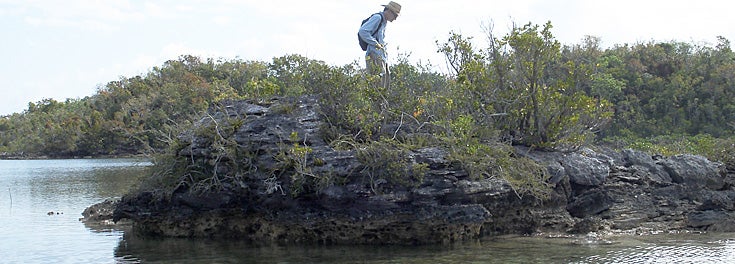
Imagine that you and a friend are dropped onto an uninhabited island to live out the rest of your lives. You’d be forced to rapidly adapt to your new environment – eating foods you might not ordinarily eat, living in a much different dwelling, learning to defend against new kinds of threats, etc. – or else you wouldn’t survive. It’s the classic tale of survival of the fittest. But would your offspring end up with shorter legs? They could. At least, that’s what happened when Biological Sciences Professor Jason Kolbe dropped off a few brown anole lizards on seven tiny islands in the Bahamas to study how multiple evolutionary forces interact.
What he discovered after four years (and many generations of anole offspring) was that the lizards’ genetic and physical traits were influenced by both natural selection (think Darwin) and a phenomenon called “founder effects,” which happen when small numbers of a particular species break off from a larger population and colonize a new territory. The new population ends up becoming somewhat different from the original population. In this case, they grew shorter legs.
The island where the anole lizards originated is forested, and the lizards there have longer legs so they can run faster on the trees’ wide perches. By contrast, the islands where Professor Kolbe dropped off his lizards have short, scrub vegetation with narrower perches, on which shorter legs are an advantage. Professor Kolbe predicted that natural selection would lead the lizards to develop shorter limbs, which is exactly what happened. Sort of. Only better.
“The lizards on all the islands experienced a decrease in leg length that is attributable to natural selection,” he explained. “But those that started out with the longest hind limbs still had the longest hind limbs. The fact that the populations maintained their order from longest to shortest limbs throughout the experiment means that both founder effects and natural selection contributed to their current differences.”
What makes his study so great is that founder effects are rarely observed in nature, with most previous studies being conducted in the laboratory. “Ours is the first to study this process experimentally in a natural setting, and we were able to account for multiple evolutionary mechanisms through time,” he said. “We manipulated the founding of these islands, but everything else about it was natural.”
Not only are Professor Kolbe’s lizards evolving, so is his experiment. When Hurricane Irene struck the islands in 2011, followed by Hurricane Sandy a year later, the anole populations on five of the seven islands were wiped out, and one of the others was left with only three lizards. So now, Professor Kolbe’s study is evolving into one that is examining how quickly populations recover from disaster and the role evolution plays.
Like the lizards, the world is evolving, and if you’re inspired to develop, discover, and adapt solutions for the worlds’ changing needs, then URI is the place for you.
